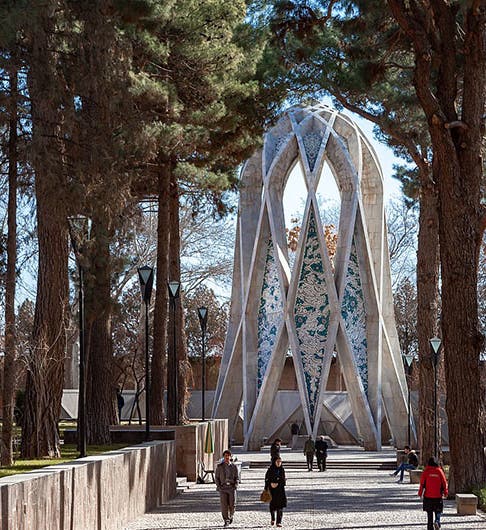Scientist of the Day - Omar Khayyam
Omar Khayyam, a Persian astronomer, mathematician, and poet, died Dec. 4, 1131, at the age of 83. Khayyam came from Nishapur, now in northeastern Iran, was educated at Samarkand, now in eastern Uzbekistan, and spent much of the rest of his life in Bukhara (now in western Uzbekistan), returning to Nishapur to live out his old age. He wrote important treatises on algebra – a branch of mathematics invented by Muslim scientists – and geometry, and did important work in astronomy, helping establish a sophisticated astronomical calendar. He was a philosopher and a follower of Avicenna. In his spare time, he wrote poetry. It is as a poet that he is now best known.
Khayyam wrote poems in a form called ruba'i, a four-line quatrain, and he wrote many of them. It used to be claimed that he composed over 1200 ruba'is, for that many have been attributed to him. Many modern scholars think the number might be one-tenth of that, or 120 (although there are also scholars who maintain that not a single ruba'i can be attributed to Omar with certainty).
No matter. His quatrains were little known in East or West until a manuscript with a collection of ruba'is – a Rubáiyát – was discovered in the Bodleian Library at Oxford by Edward Byles Cowell in 1857. He copied the verses and brought them to the attention of a former student and fellow orientalist, Edward Fitzgerald (second image), who decided to translate the verses into English. The Rubáiyát of Omar Khayyam was published on Jan. 15, 1859, and contained 75 of Khayyam's ruba'is, or what were claimed to be his (third image). The book was not a great initial success, but it did have a second edition in 1868, now with 110 quatrains. It was still not much in demand, until it was discovered by William Morris and the Pre-Raphaelites, and with that, the tag team of Omar Khayyam/Edward Fitzgerald was off and running. It is now the most popular selection of verse ever translated into English.
Most of the ruba'is have nothing to do with science, but there are a few that I used to read to my Darwin class in order to debate the question, what if Darwin had known Fitzgerald's Rubáiyát, and had opted to choose a line or two to include on a preliminary quotation page in The Origin of Species, published 10 months after the Rubáiyát? What would he have chosen? Here are the three rubai’s I would read:
Stanza 49
'Tis all a Chequer-board of Nights and DaysWhere Destiny with Men for Pieces plays:Hither and thither moves, and mates, and slays,And one by one back in the Closet lays.
Stanza 51
The Moving Finger writes; and, having writ,Moves on: nor all thy Piety nor Wit,Shall lure it back to cancel half a Line,Nor all thy Tears wash out a Word of it.
And then two together, Stanzas 59-60 (59-66 form a sub-unit, called “The Book of Pots”):
Listen again. One Evening at the CloseOf Ramazán, ere the better Moon arose,In that old Potter's Shop I stood aloneWith the clay Population round in Rows And strange to tell, among that Earthen LotSome could articulate, while others not:And suddenly one more impatient cried"Who is the Potter, pray, and who the Pot?"
The students and I agreed on little, except that "Who is the Potter, pray, and who the Pot?" was the best line, and Darwin would never have chosen it.
Many have remarked on the oddity that Omar Khayyam, an excellent mathematician and astronomer who wrote quatrains for fun, should be remembered primarily for the Rubáiyát, and that Fitzgerald, an otherwise undistinguished orientalist who lived seven centuries later, should have found his sole fame with the same book. The great Argentine essayist, Jorge Luis Borges, wrote a compelling piece on Fitzgerald and Omar Khayyam, which was called "The Enigma of Edward Fitzgerald" and was included in the collection Other Inquisitions (1964). Borges made the point (at some length and much more eloquently than I am summarizing it here) that sometimes when one writer interprets another, what emerges is far more beautiful and powerful than either could have produced alone. As he concluded: "A miracle happens: from the fortuitous conjunction of a Persian astronomer who condescends to write poetry, and an eccentric Englishman who peruses Oriental and Hispanic books, perhaps without completely understanding them, there emerges an extraordinary poet who does not resemble either of them." A poet who, perhaps, is neither the Potter nor the Pot.
There is a splendid Mausoleum for Omar Khayyam in Nishapur, designed by the great Iranian architect and sculptor, Houshang Seyhoun (first image). There are many statues and busts of Khayyam throughout Europe, the Middle East, and Central Asia. The one I like best is in the Omar Khayyam Gardens in Nishapur, but it is hard to get a good photograph of it, because it is now protected by a surrounding glass barrier (fourth image).
Dr. William B. Ashworth, Jr., Consultant for the History of Science, Linda Hall Library and Associate Professor emeritus, Department of History, University of Missouri-Kansas City. Comments or corrections are welcome; please direct to ashworthw@umkc.edu.









